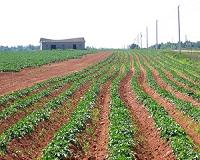 |
Corvallis OR (SPX) Feb 14, 2011 The application of a naturally occurring pheromone to honey bee test colonies increases colony growth resulting in stronger hives overall, according to a new study conducted by scientists at Oregon State University and Texas A and M University. The study, which appeared this week in the journal, PLoS ONE, comes amid national concern over the existence of honey bee Colony Collapse Disorder (CCD) - a combination of events that result in the death of a bee colony. The causes behind CCD remain unknown, but researchers are focusing on four possible contributing factors: disease, pests, environmental conditions and nutrition. According to Ramesh Sagili, coauthor on the study, "Division of labor associated with brood rearing in the honey bee: how does it translate to colony fitness?" resiliency to CCD may be increased through -better hive management and the use of optimal dose of brood pheromone - a chemical released by honey bee larvae that communicates the presence of larvae in the colony to adult bees. Optimal dose of brood pheromone that can stimulate colony growth may vary depending on the colony size, time of application and several other factors. The number of larvae present in the hive affects the ratio of adult foraging bees to non-foragers in favor of foragers, said Sagili. In our study, when low levels of brood pheromone were introduced to experimental hives foragers collected more pollen. Nectar is a carbohydrate source for both adults and larvae, while pollen is the primary source of protein. Nurse bees utilize pollen to produce brood food that is provisioned to the growing larvae in the colony. More pollen is equitable to better overall nutrition, one of the areas of concern in the appearance of CCD. "The low brood pheromone treatment triggered higher pollen collection in the study," said Sagili,who holds an OSU Extension Service appointment and studies honey bee health, nutrition, pheromone biology and pollination in OSU's Department of Horticulture. "Colonies exposed to low levels of synthetic brood pheromone exhibited higher foraging populations, a decrease in the age of first foraging and greater foraging effort. The result is increased colony growth - an indicator of colony fitness." The researchers also treated colonies with high levels of brood pheromone. They found the higher treatments were ineffective in increasing the number of foraging bees present in the colony, and in changing the amount of pollen an individual- bee brought back to the hive. "It's logical to assume that a higher dose of pheromone would result in higher pollen collection within the colonies as it would signify more larvae to rear," said Sagili. "Our results did not support that assumption." An upper threshold for the pheromone may exist and when that threshold is reached a negative feedback might kick in and colonies may try to balance the ratio of adults to larvae, and that in turn may lead to higher number of adults remaining in the nest for brood care and less bees foraging for resources, said Sagili. - Brood pheromone is not currently used in commercial bee keeping, however it's application in research may result in the uncovering of mechanisms related to the division of labor, foraging strategies and colony fitness. The study is available online.
Share This Article With Planet Earth
Related Links Oregon State University Farming Today - Suppliers and Technology
 Toward Controlling Fungus That Caused Irish Potato Famine
Toward Controlling Fungus That Caused Irish Potato FamineWashington DC (SPX) Jan 21, 2011 Scientists are reporting a key advance toward development of a way to combat the terrible plant diseases that caused the Irish potato famine and still inflict billions of dollars of damage to crops each year around the world. Their study appears in ACS' bi-weekly journal Organic Letters. Teck-Peng Loh and colleagues point out that the Phytophthora fungi cause extensive damage to food ... read more |
|
| The content herein, unless otherwise known to be public domain, are Copyright 1995-2010 - SpaceDaily. AFP and UPI Wire Stories are copyright Agence France-Presse and United Press International. ESA Portal Reports are copyright European Space Agency. All NASA sourced material is public domain. Additional copyrights may apply in whole or part to other bona fide parties. Advertising does not imply endorsement,agreement or approval of any opinions, statements or information provided by SpaceDaily on any Web page published or hosted by SpaceDaily. Privacy Statement |